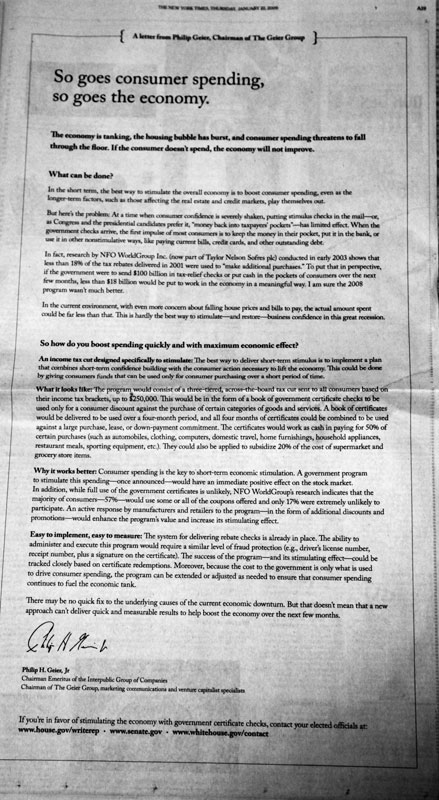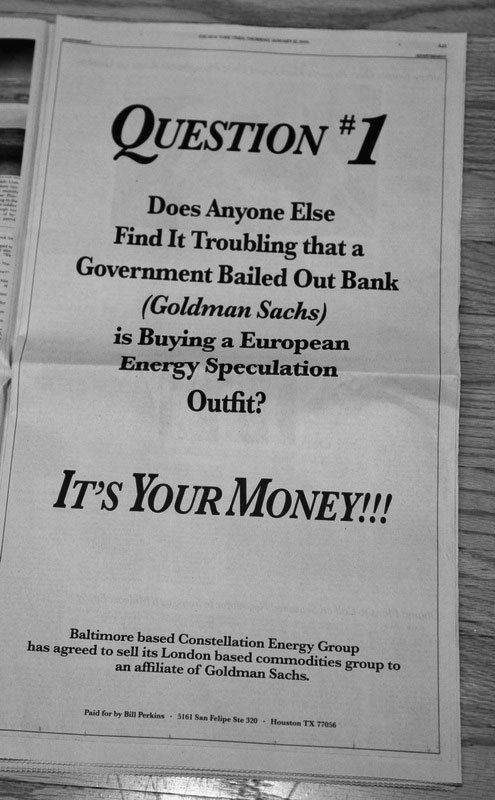I’m baffled by WhosHere. And I’m no newbie. I built my first Web page in 1994, wrote my first blog entry in 1999, and sent my first tweet in October 2006. My user number on Yahoo’s event site, Upcoming.org: 14. I love tinkering with new gadgets and diving into new applications. But WhosHere had me stumped. It’s an iPhone app that knows where you are, shows you other users nearby, and lets you chat with them. Once it was installed and running, I drew a blank. What was I going to do with this thing?
So I asked for some help. I started messaging random people within a mile of my location (37.781641 °N, 122.393835 °W), asking what they used WhosHere for.
“Government Checks for Consumer Spending?”

Philip Geier’s 232K PDF advertisement in today’s fishwrap edition of the New York Times. Use the grandkids credit cards to spend now…..
Our Tax Dollars Supporting Goldman Sach’s Latest Acquisition

Bill Perkins is at it again in the New York Times. More Bill Perkins activism on the bailout/splurge, here.
TARP Funds: State by State Analysis
In unveiling its bank-share purchase program, the Treasury Department required nine of the nation’s largest financial-services companies to sell a total of $125 billion in preferred stock to the government, and said an additional $125 billion in stock could be bought from other firms on a voluntary basis. Below, see a list of participating companies.
Sunrise: Madison’s Vilas Park

A very pleasant sunrise this morning, perhaps to a warmer day?
Madison’s Building “Boomlet”
Even as Madison, Wis., suffers arctic-like temperatures, there is a warm ray of hope for the commercial real-estate industry.
The city’s academic sector is seeing a building boomlet while developers in other parts of the country slam the brakes on new office buildings, stores and shopping centers.
A student-services hub at the University of Wisconsin-Madison is part of a larger mixed-use project called University Square.
About $600 million of new building projects are under construction on the University of Wisconsin-Madison campus and more than $450 million of additional projects are in the planning stage, said Alan Fish, associate vice chancellor of facilities planning and management at the university.A student-services center will officially open to students this week in a larger mixed-use development called University Square. The 1.1-million-square-foot project developed by Executive Management Inc., of Madison, also includes a rooftop garden, rental housing and about 125,000 square feet of retail space that is about 55% leased. The project, on the edge of the campus, is on land previously occupied by a one-story retail property, Mr. Fish said. Also under construction is the $150 million Wisconsin Institutes for Discovery, an interdisciplinary research complex scheduled to open in 2010.
The construction, part of a continuing effort to update the campus’s facilities since the 1990s, isn’t just changing the face of secluded ivory towers. “We’re smack dab in the middle of Madison,” Mr. Fish said. “Clearly the dynamism the campus has exhibited in the last five years has had a big ripple effect.”
600 Private Jets Expected for the Obama Nomination; 2X the 2004 Number
For the wealthy, Tuesday’s inauguration is the dream party: a chance to rub elbows with the similarly rich and powerful, to become part of a historic moment, and (most importantly), to get access to the man of the moment.
It also is a chance to drown their financial sorrows in an emotional wave of optimism.
Yet it may come as a surprise that at a time of financial crisis and Green correctness, many of the wealthy are choosing to arrive by private jet.
According to an article in Bloomberg, as many as 600 private jets were expected to touch down in D.C. for the inauguration. The runway at Washington Dulles was closed Saturday to allow as many as 100 small planes to park. And the Metropolitan Washington Airports Authority said it expected a total of 500 small jets to land from Jan. 16 through Jan 21.
“That would set a record, topping the 300 the airport accommodated for President George W. Bush’s 2004 inaugural,” an Airports Authority says in the article.
A Crackdown on Vietnam’s Press
LIKE their counterparts in China, Vietnam’s ruling Communists seem even more than usually sensitive to criticism. This month two leading reformist newspaper editors, Nguyen Cong Khe, of Thanh Nien (Young People), and Le Hoang, of Tuoi Tre (Youth Daily), were both told that their contracts would not be renewed, apparently because they were too good at their jobs. Their papers have assiduously uncovered official corruption, most notably with a joint exposé in 2006 about a crooked transport-ministry road-building unit. The journalists behind that story were punished by a Hanoi court last October for “abusing democratic freedoms”. Now it looks as if their editors, too, have been culled. A spate of other arrests last year suggests a wider clampdown.
AFP Read all about it (or not)Ever since the start of doi moi (renewal) reforms in 1986, economic liberalisation has been accompanied by a gradual political loosening. There are around 700 newspapers in circulation. All are government controlled, but some are relatively outspoken. Meanwhile, a young, tech-savvy population has taken to reading opinion on the internet, in blogs penned by pseudonymous authors. These commentators are questioning government policy with increasing zeal. A day after the two journalists were arrested last year, their newspapers openly attacked the government’s actions, hitting a few raw nerves. The government now also wants to curb the pesky bloggers, announcing rules in December restricting politically sensitive content on the internet.